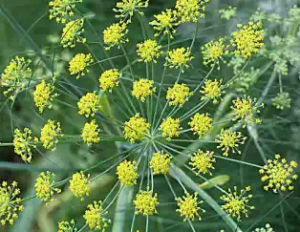Table of Contents
Mishreya
Foenilculum vulghare mill – Ayurvedic Herb
LITERARY REVIEW
The drug mishreya has been mentioned by charaka under Madhura skanda.
In this varga chatra and atichatra described. It is identified as foeniculum vulgare.
Sharasaghara quoted mishreya as the example for deepaniya dravya.
SYNONYMS AND INTERPRETATION
- Mishreya
It can attain in the other aushada guna . posses good qualities by nature.
- Avakrishna
The flower are looking downwards.
- Chatra
Inflorescence is umbella shaped.
- Talaparni
Leaf shape is like that of palm tree leaf.
- Misi
Makes particular sound while pouring fruits in container.
- Madhurika
It has sweet taste.
DIFFERENT VARITIES
- Vanya – which grows wild.
- Gramya – cultivated.
VERNACULAR NAMES
English – fennel.
Hindi – saompha.
Kannada – Badisoppu.
Malayalam – perumijirakam, perinurakam.
Gujurati – variyali.
Tamil- soumbu.
Telugu –sompu.
OFFICINAL PART
- Whole plant.
- Oil
- roots
- fruits.
DOSAGE
- Phala charna – 3-6gm.
- Moola choorna – 3-6gm.
- Moola kwatha – 50-100ml.
- Arka – 20-40ml.
- Taila – 5-10 drops.
- Bija – 6 masha.
CHEMICAL CONSTITUENTS
- Fruits :- active principle called anethol.
- Others :- pentoran, pectin, starch like trigonilla, chlorine,iodine (20-80/100mg) fanchone, myricticin, coumarin, flavanoids, phenolic acid, billanosids, volatile oils.
- Fixed oil :- 9-13% of vitamins.
- Vitamin A – 139/100mg.
- Vitamin B1 – 36/100mg.
- Vitamin B2 – 0.37/100mg.
- Vitamin C- 9.31mg/100mg.
- Oil- anethol (50-60%) anise camphor, fenelore, variable liquid.
- Essential oil:- Benene, d-timonene, d-phelladean, eugenol, phelladrin, dihydrocarome, caruacrol, satrol, thymol.
- Seed oil :- triptoselentin, petxoselenie cliolum, ditxoseline.
- Herb:- scopeletin, caumarin, stigmasterol, scopolethin, umbelliferon, esthole.
- Leaves :- phellandrin, taspenins, apeole, pellistin.
PROPERITIES
- Rasa – Madhura, katu.
- Guna – snigdha, laghu.
- Vipaka – Madhura.
- Veerya – sheeta.
- Dosa, karma – vata, pitha vatanulomana deepana pachana anuloma recana hrdya raktha prasadana.
CONTEROVERSIAL STUDIES
From the description of bhavamishra it be concluded the chatra and alichatra of classical literature may be foeniculum vulgare and A. sowa, mill respectively.
INDICATIONS
- According to R.N
Precharoga, taaluroga, arsadosha.
- According to K.N
Krimi, baddavit, kara, aruchi, vrana.
- According to P.N
Amaatisara, shoola, deepana pachana.
- According to B.P
PHARMACOTHERAPEUTIC ACTIONS AND USES
- Paste :- it is applied on head in case of mental retardation and vision related problems.
- Powder: – it regularizes digestion and improcess total gastro intestinal tract. It also normalize peristative movement in the digestion tract. It supports the heartly condition and improcess the blood circulation.
- It is vata-pitta sepressent.
- It is one of the great eye tonic and strengths nervous system.
- It regularizes the digestive movements in the body.
- It supports the C.V.S for proper functioning.
THERAPEUTIC USES
External
- Taila abhyanda is bala jwara.
- Crushed fruit by applying to skin causes relief giddiness head ache due to summer season.
- Fruit used to improve eye-sight.
- Oil is used for massaging in pain abdomen.
- Decocation used for fermentation on swelling and painful areas.
- Leaf plate for application of practice.
Internal
- Infusion prepared with 8-12 fruit in 500cc of boiling water employed as enema for infants for the explusion of flatees.
- Hot infusion of fruits used in indigenous medicine to increase secretion and stimulate sweating.
- It is used in fewer, indigestion, vomiting.
- Oil put in to ear in ear ache.
- Kwata used as basthi in adhmana.
- Hot infusion in amenorrhea.
RESEARCH
Oral administration of seed extract for 15 days to male rats decreased total protein concentration in tests and vas defence but increased it in seminal vesicles and prostate gland; acid and alkaline phosphatase activities decreased in all these tissues. In female rats, moderated doses. Increased weight of oviduct; endometrium. Cervix and vagina (Ind.J.physiol pharmacol).
FORMULATIONS
- Shatapushpaadi arka – arka prakasha.
- Shatapushpaadi choorna – Bhaishajya ratnavali, yogaratnakarma
- Mishrya arka – Bhaishajya ratnavali, yogaratnakarma.
FOLKORE USES
- Fruit used to improve eye-sight.
- Leaf paste for application of pouttice.
- Decoration is used for fermentation on swelling.
- Kwatha used as basthi in adhama.
ECOLOGY
- A herb of the tropic and sub tropic region.
- Annual aromatic cultivated herb.
- It is grown in a garden or honey and crop.
- Extensively cultivated during cold season.
CULTIVATION AND HARVESTING
Foeniculum vulgare mill ‘purpureum’ or ‘vigra’, ‘bronze-leaved’ fernel is widely available as a decorative garden plant.
Fernel has become naturalized along road side, in pasteurs, and in other open sites in many regions, including northern Europe, the united states, southern Canada and in much of asia and Australia it propogates well by seed and is considered as invasive species and weed in Australia and the united states in western north America fernel can be found from the coastal and inland -wildland urban interface east in to hill and mountain areas excluding desert habitats.
- Fernel is widely cultivated both in its nature range and else where for its edible strongly flavoured leaves and fruits its aniseed flavour comes from anethol an aromatic compound also found in anise and star anise and its taste aroma are similar to their though usually not a strong the florence fernel is cultivated group with inflated leaf base which form a bulb like structure
- Harvesting is done through the year.
OTHER THAN MEDICINAL USES
- The oil fernel or mishrey taila is largely used as a flavouring agent in culinary preparations, cordeals.
- It is used in scenting of cosmetic use.
- It is aromatic, stimulant and carminative.
- Commonly grown in gardens and home yards.

